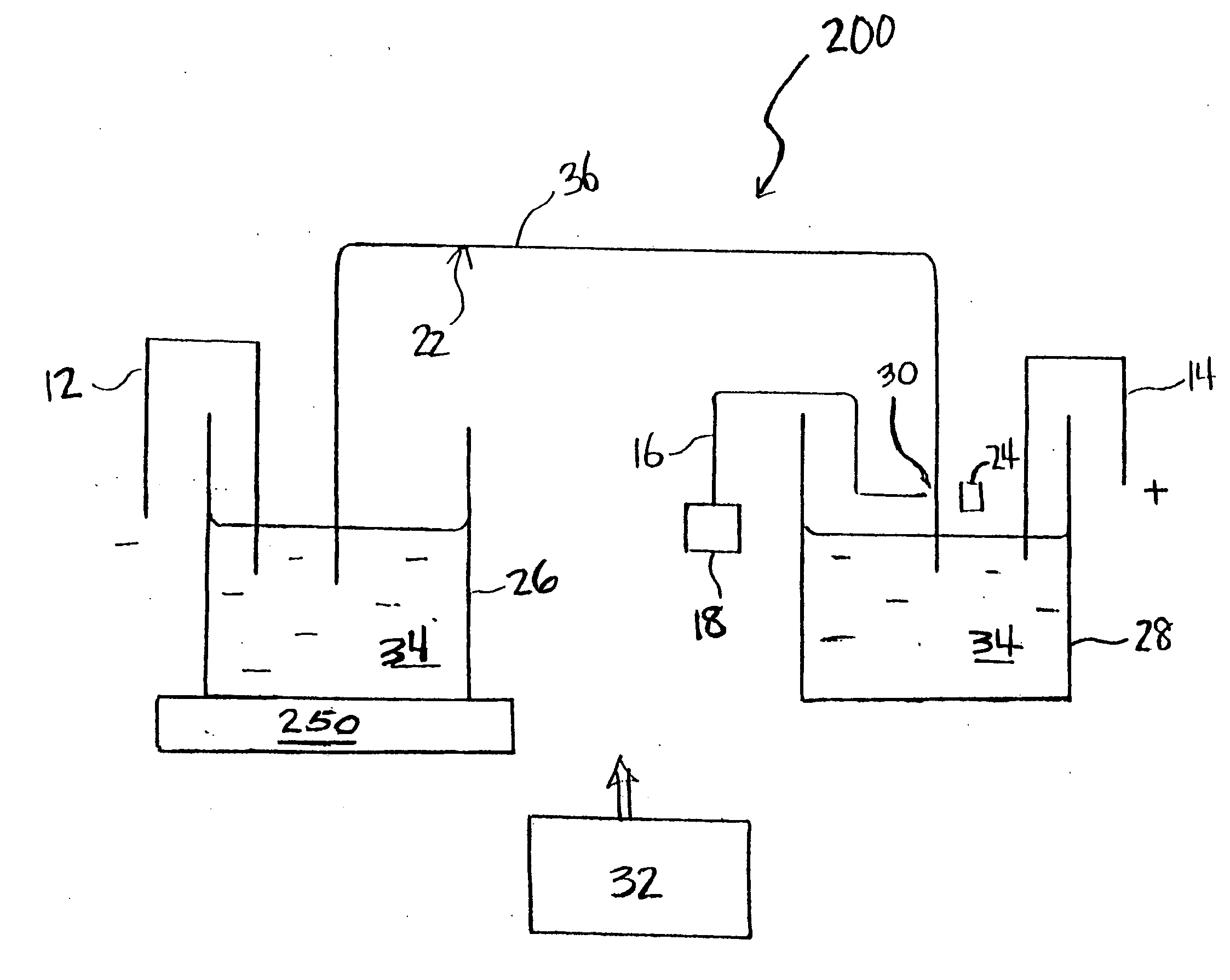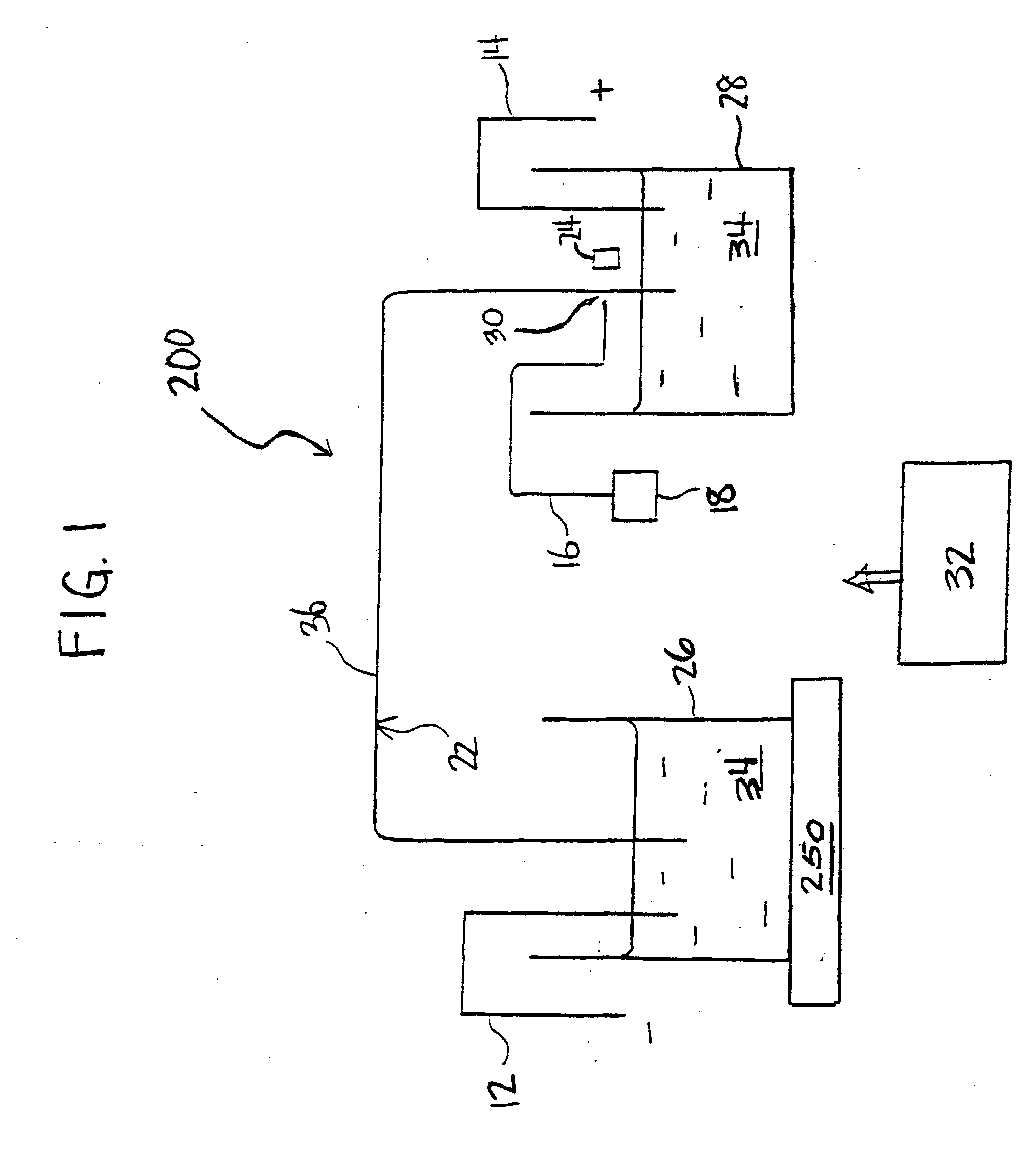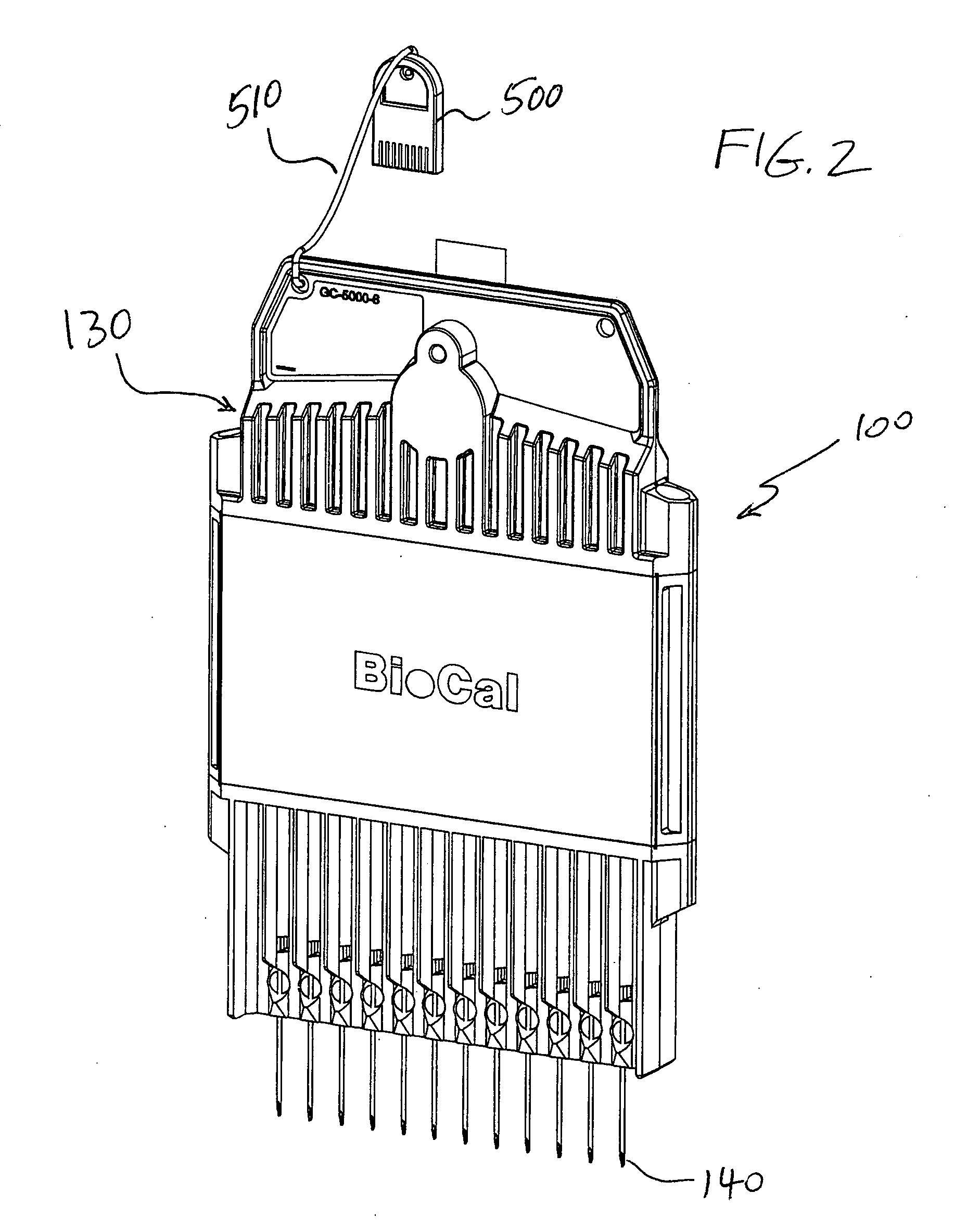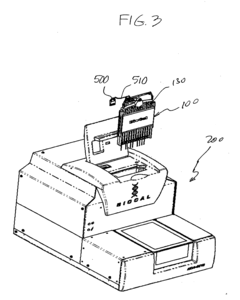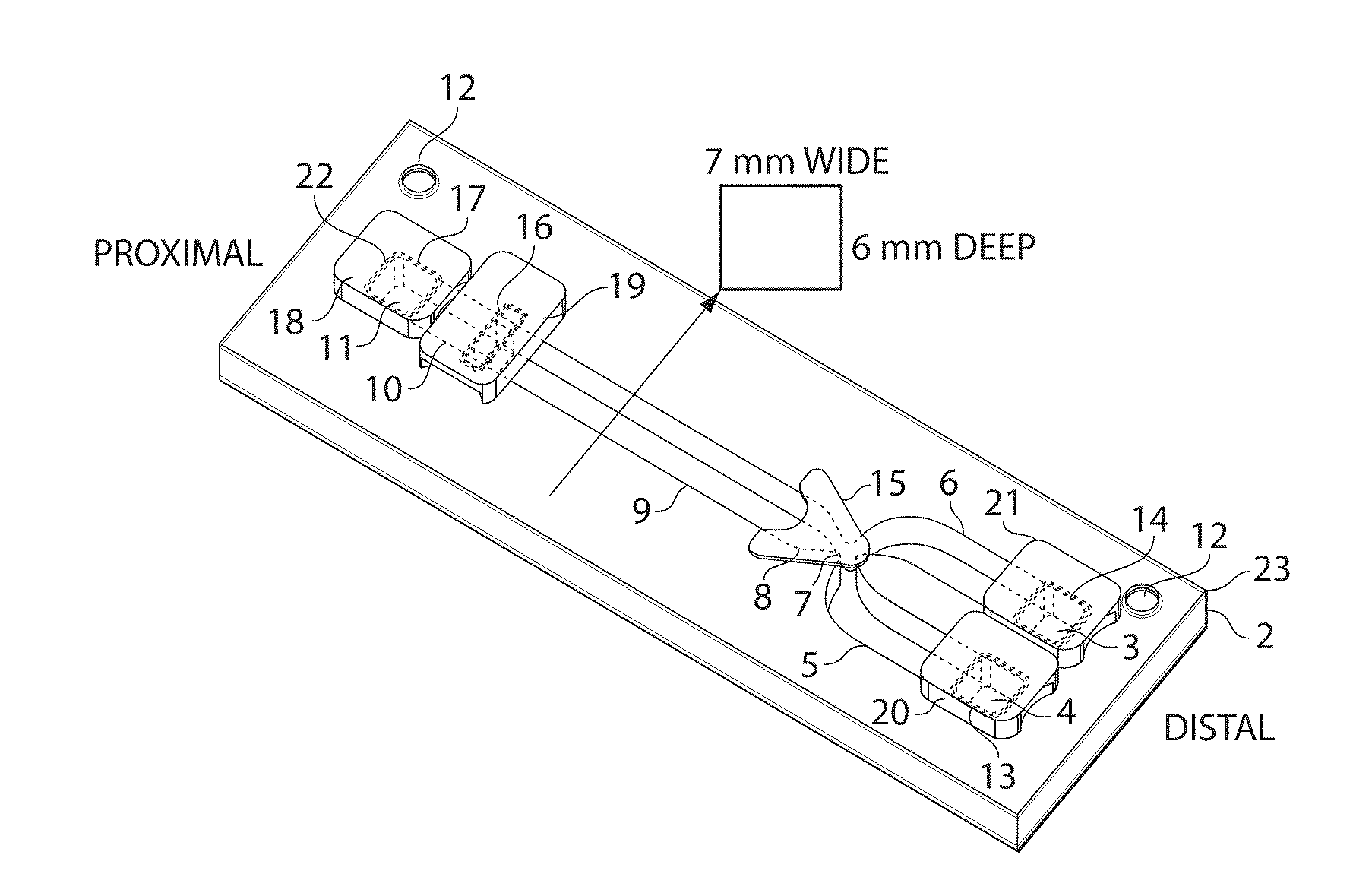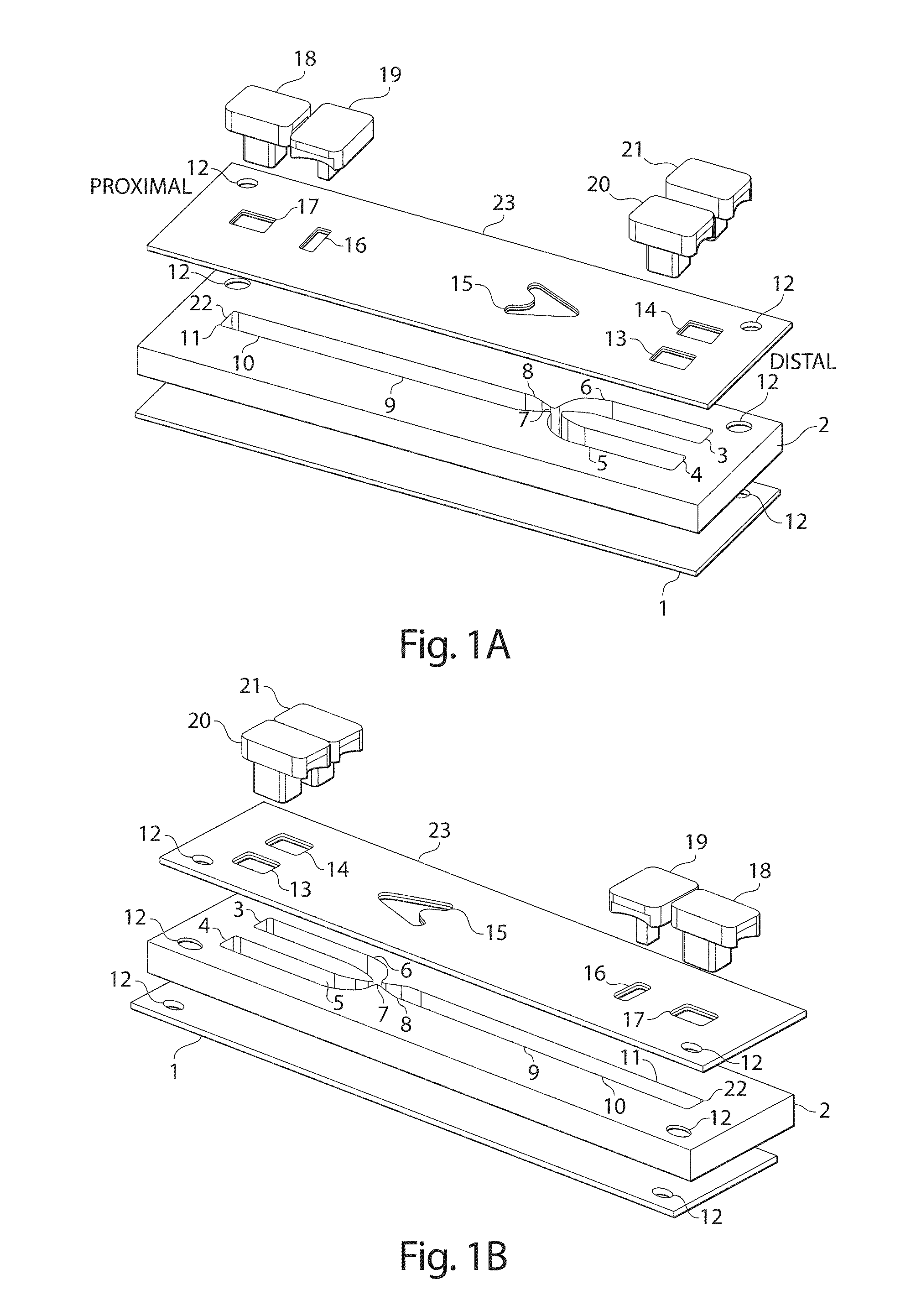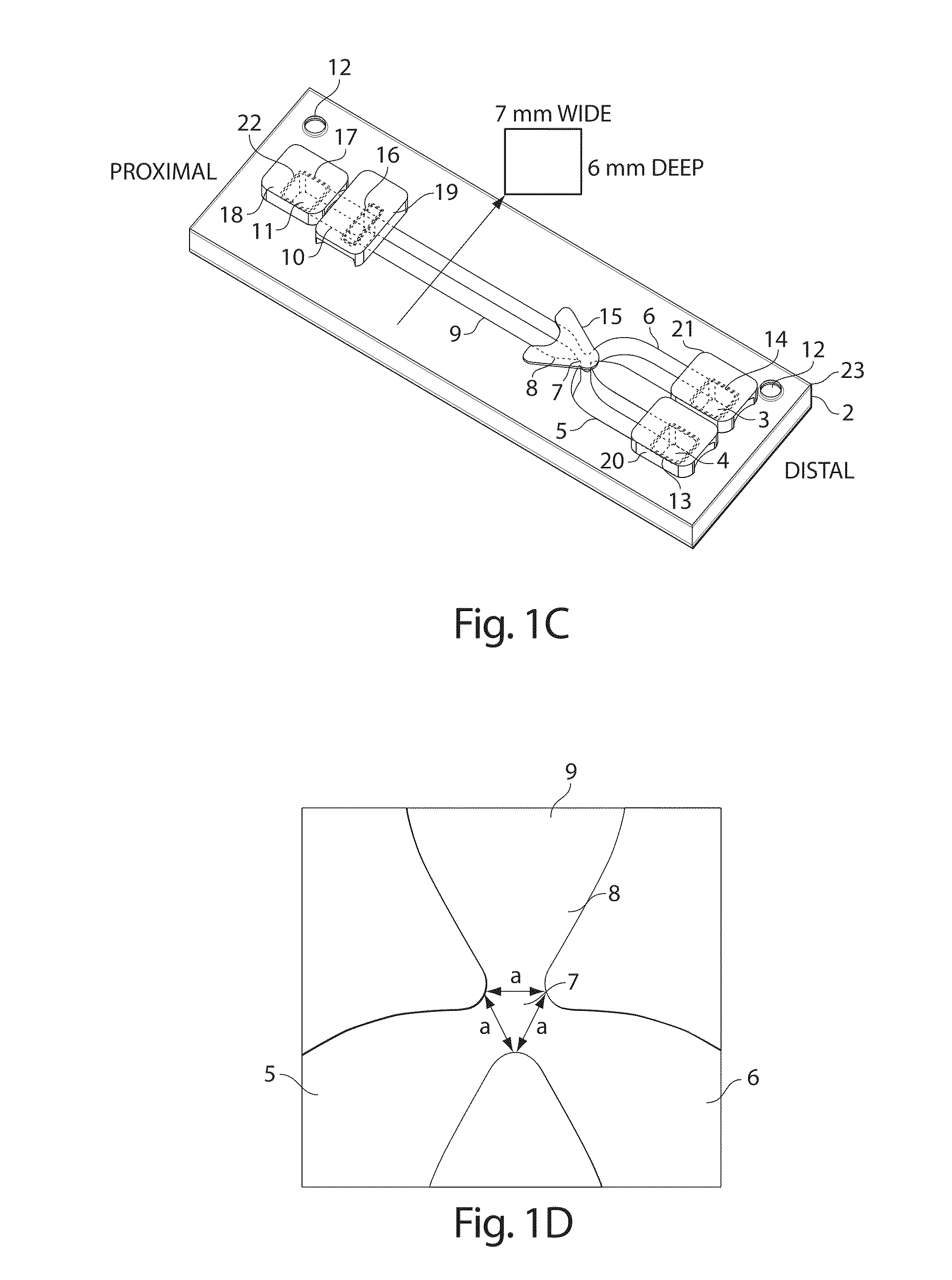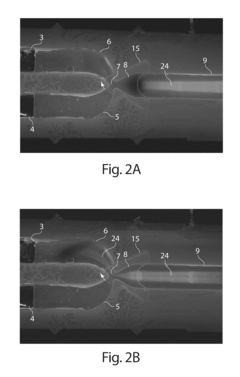Gel Electrophoresis Techniques for DNA Analysis
JUN 30, 20259 MIN READ
Generate Your Research Report Instantly with AI Agent
Patsnap Eureka helps you evaluate technical feasibility & market potential.
DNA Analysis Background and Objectives
Gel electrophoresis has been a cornerstone technique in DNA analysis since its inception in the 1960s. This method, which separates DNA fragments based on their size and charge, has revolutionized molecular biology and forensic science. The evolution of gel electrophoresis techniques has been driven by the increasing demand for more precise, rapid, and high-throughput DNA analysis in various fields, including genomics, diagnostics, and personalized medicine.
The primary objective of research on gel electrophoresis techniques for DNA analysis is to enhance the resolution, speed, and sensitivity of DNA separation. This involves developing new gel materials, optimizing buffer systems, and improving detection methods. Additionally, researchers aim to miniaturize and automate the process, making it more accessible and cost-effective for widespread use in both research and clinical settings.
One of the key trends in gel electrophoresis research is the development of capillary electrophoresis and microfluidic devices. These technologies offer advantages such as reduced sample volume requirements, faster analysis times, and the potential for integration with other analytical techniques. Another important focus is the improvement of DNA visualization methods, moving beyond traditional ethidium bromide staining to more sensitive and safer fluorescent dyes.
The field of DNA sequencing has also significantly influenced the direction of gel electrophoresis research. While next-generation sequencing technologies have largely replaced gel-based methods for large-scale genomic studies, there is still a crucial role for gel electrophoresis in quality control, fragment size selection, and validation of sequencing results.
Researchers are exploring novel applications of gel electrophoresis in emerging areas such as single-cell genomics and epigenetics. These fields require highly sensitive techniques capable of analyzing minute amounts of DNA and detecting subtle modifications. Consequently, there is a growing interest in developing ultra-high-resolution gels and specialized separation matrices.
The environmental impact of gel electrophoresis is another area of concern, prompting research into more sustainable and eco-friendly alternatives to traditional polyacrylamide and agarose gels. This includes the exploration of biodegradable materials and the development of gel-free electrophoresis systems.
As we look to the future, the objectives of gel electrophoresis research are likely to focus on further integration with other analytical platforms, increased automation, and the development of portable, point-of-care devices for rapid DNA analysis. These advancements will continue to expand the applications of gel electrophoresis in fields ranging from molecular diagnostics to environmental monitoring and forensic investigations.
The primary objective of research on gel electrophoresis techniques for DNA analysis is to enhance the resolution, speed, and sensitivity of DNA separation. This involves developing new gel materials, optimizing buffer systems, and improving detection methods. Additionally, researchers aim to miniaturize and automate the process, making it more accessible and cost-effective for widespread use in both research and clinical settings.
One of the key trends in gel electrophoresis research is the development of capillary electrophoresis and microfluidic devices. These technologies offer advantages such as reduced sample volume requirements, faster analysis times, and the potential for integration with other analytical techniques. Another important focus is the improvement of DNA visualization methods, moving beyond traditional ethidium bromide staining to more sensitive and safer fluorescent dyes.
The field of DNA sequencing has also significantly influenced the direction of gel electrophoresis research. While next-generation sequencing technologies have largely replaced gel-based methods for large-scale genomic studies, there is still a crucial role for gel electrophoresis in quality control, fragment size selection, and validation of sequencing results.
Researchers are exploring novel applications of gel electrophoresis in emerging areas such as single-cell genomics and epigenetics. These fields require highly sensitive techniques capable of analyzing minute amounts of DNA and detecting subtle modifications. Consequently, there is a growing interest in developing ultra-high-resolution gels and specialized separation matrices.
The environmental impact of gel electrophoresis is another area of concern, prompting research into more sustainable and eco-friendly alternatives to traditional polyacrylamide and agarose gels. This includes the exploration of biodegradable materials and the development of gel-free electrophoresis systems.
As we look to the future, the objectives of gel electrophoresis research are likely to focus on further integration with other analytical platforms, increased automation, and the development of portable, point-of-care devices for rapid DNA analysis. These advancements will continue to expand the applications of gel electrophoresis in fields ranging from molecular diagnostics to environmental monitoring and forensic investigations.
Market Demand for DNA Analysis Tools
The market demand for DNA analysis tools has been experiencing significant growth in recent years, driven by advancements in genomics research, personalized medicine, and forensic applications. Gel electrophoresis techniques, particularly for DNA analysis, play a crucial role in this expanding market.
In the research and academic sector, there is a strong demand for DNA analysis tools to support various genomic studies, including gene expression analysis, mutation detection, and genetic mapping. Universities, research institutions, and biotechnology companies are continuously seeking more efficient and accurate methods for DNA separation and analysis, driving the need for improved gel electrophoresis techniques.
The healthcare industry represents a substantial portion of the market demand for DNA analysis tools. With the rise of personalized medicine, there is an increasing need for genetic testing and molecular diagnostics. Hospitals, clinical laboratories, and diagnostic centers require reliable and high-throughput DNA analysis methods to support patient care and disease management. Gel electrophoresis techniques are essential in these applications for analyzing genetic markers, identifying genetic disorders, and assessing disease risk.
Forensic science is another key driver of market demand for DNA analysis tools. Law enforcement agencies, forensic laboratories, and judicial systems rely on DNA analysis for criminal investigations, paternity testing, and victim identification. The need for accurate and rapid DNA profiling techniques has led to a growing demand for advanced gel electrophoresis methods that can handle complex samples and provide reliable results.
The pharmaceutical and biotechnology industries also contribute significantly to the market demand for DNA analysis tools. These sectors utilize gel electrophoresis techniques in drug discovery, development of gene therapies, and quality control of biopharmaceutical products. As the biopharmaceutical market continues to expand, the demand for sophisticated DNA analysis tools is expected to grow correspondingly.
Environmental and food safety applications represent emerging areas of market demand for DNA analysis tools. Gel electrophoresis techniques are increasingly used for detecting genetically modified organisms (GMOs), identifying food contaminants, and monitoring environmental biodiversity. Regulatory agencies and food manufacturers are adopting these tools to ensure compliance with safety standards and meet consumer demands for transparency in food production.
The global market for DNA analysis tools, including gel electrophoresis techniques, is projected to grow at a compound annual growth rate (CAGR) of over 6% in the coming years. This growth is fueled by technological advancements, increasing research and development activities, and the expanding applications of DNA analysis across various industries.
In the research and academic sector, there is a strong demand for DNA analysis tools to support various genomic studies, including gene expression analysis, mutation detection, and genetic mapping. Universities, research institutions, and biotechnology companies are continuously seeking more efficient and accurate methods for DNA separation and analysis, driving the need for improved gel electrophoresis techniques.
The healthcare industry represents a substantial portion of the market demand for DNA analysis tools. With the rise of personalized medicine, there is an increasing need for genetic testing and molecular diagnostics. Hospitals, clinical laboratories, and diagnostic centers require reliable and high-throughput DNA analysis methods to support patient care and disease management. Gel electrophoresis techniques are essential in these applications for analyzing genetic markers, identifying genetic disorders, and assessing disease risk.
Forensic science is another key driver of market demand for DNA analysis tools. Law enforcement agencies, forensic laboratories, and judicial systems rely on DNA analysis for criminal investigations, paternity testing, and victim identification. The need for accurate and rapid DNA profiling techniques has led to a growing demand for advanced gel electrophoresis methods that can handle complex samples and provide reliable results.
The pharmaceutical and biotechnology industries also contribute significantly to the market demand for DNA analysis tools. These sectors utilize gel electrophoresis techniques in drug discovery, development of gene therapies, and quality control of biopharmaceutical products. As the biopharmaceutical market continues to expand, the demand for sophisticated DNA analysis tools is expected to grow correspondingly.
Environmental and food safety applications represent emerging areas of market demand for DNA analysis tools. Gel electrophoresis techniques are increasingly used for detecting genetically modified organisms (GMOs), identifying food contaminants, and monitoring environmental biodiversity. Regulatory agencies and food manufacturers are adopting these tools to ensure compliance with safety standards and meet consumer demands for transparency in food production.
The global market for DNA analysis tools, including gel electrophoresis techniques, is projected to grow at a compound annual growth rate (CAGR) of over 6% in the coming years. This growth is fueled by technological advancements, increasing research and development activities, and the expanding applications of DNA analysis across various industries.
Current Gel Electrophoresis Challenges
Gel electrophoresis remains a cornerstone technique in DNA analysis, yet it faces several challenges that limit its effectiveness and efficiency. One of the primary issues is the resolution and separation of DNA fragments, particularly for large molecules or those with similar sizes. Traditional agarose gels struggle to differentiate between fragments that differ by less than 10-20 base pairs, which can be crucial in certain genetic analyses.
The time-consuming nature of gel electrophoresis poses another significant challenge. Standard protocols can take several hours to complete, which is problematic in scenarios requiring rapid results, such as clinical diagnostics or forensic investigations. This lengthy process also increases the risk of sample degradation and affects the overall throughput of laboratories.
Sensitivity and detection limits continue to be areas of concern. While staining techniques have improved, detecting low concentrations of DNA remains challenging. This is particularly problematic when working with limited sample quantities or in applications requiring high sensitivity, such as single-cell genomics or ancient DNA analysis.
Reproducibility and standardization across different laboratories present ongoing challenges. Variations in gel composition, running conditions, and imaging techniques can lead to inconsistent results, making it difficult to compare data between different research groups or clinical settings. This lack of standardization hampers the broader applicability and reliability of gel electrophoresis-based analyses.
Environmental and safety concerns associated with traditional DNA stains, such as ethidium bromide, have prompted the search for safer alternatives. However, many of these alternatives come with trade-offs in terms of sensitivity or ease of use, creating a balance between safety and performance that researchers must navigate.
The limitations in quantitative analysis also pose challenges. While gel electrophoresis is excellent for qualitative assessments, accurate quantification of DNA can be problematic due to variations in staining efficiency and the non-linear relationship between band intensity and DNA concentration at higher levels.
Automation and integration with other analytical techniques remain areas for improvement. The manual nature of many gel electrophoresis procedures limits its integration into high-throughput workflows and automated systems, which are increasingly important in modern molecular biology and genomics research.
Addressing these challenges is crucial for advancing gel electrophoresis techniques in DNA analysis. Innovations in gel materials, detection methods, and automation are actively being pursued to overcome these limitations and enhance the capabilities of this fundamental analytical tool.
The time-consuming nature of gel electrophoresis poses another significant challenge. Standard protocols can take several hours to complete, which is problematic in scenarios requiring rapid results, such as clinical diagnostics or forensic investigations. This lengthy process also increases the risk of sample degradation and affects the overall throughput of laboratories.
Sensitivity and detection limits continue to be areas of concern. While staining techniques have improved, detecting low concentrations of DNA remains challenging. This is particularly problematic when working with limited sample quantities or in applications requiring high sensitivity, such as single-cell genomics or ancient DNA analysis.
Reproducibility and standardization across different laboratories present ongoing challenges. Variations in gel composition, running conditions, and imaging techniques can lead to inconsistent results, making it difficult to compare data between different research groups or clinical settings. This lack of standardization hampers the broader applicability and reliability of gel electrophoresis-based analyses.
Environmental and safety concerns associated with traditional DNA stains, such as ethidium bromide, have prompted the search for safer alternatives. However, many of these alternatives come with trade-offs in terms of sensitivity or ease of use, creating a balance between safety and performance that researchers must navigate.
The limitations in quantitative analysis also pose challenges. While gel electrophoresis is excellent for qualitative assessments, accurate quantification of DNA can be problematic due to variations in staining efficiency and the non-linear relationship between band intensity and DNA concentration at higher levels.
Automation and integration with other analytical techniques remain areas for improvement. The manual nature of many gel electrophoresis procedures limits its integration into high-throughput workflows and automated systems, which are increasingly important in modern molecular biology and genomics research.
Addressing these challenges is crucial for advancing gel electrophoresis techniques in DNA analysis. Innovations in gel materials, detection methods, and automation are actively being pursued to overcome these limitations and enhance the capabilities of this fundamental analytical tool.
Existing Gel Electrophoresis Methods
01 Gel electrophoresis apparatus and methods
Various apparatus and methods for performing gel electrophoresis DNA analysis are described. These include improvements in gel composition, electrode design, and overall system configuration to enhance separation and detection of DNA fragments.- Gel electrophoresis apparatus and methods: Various apparatus and methods for performing gel electrophoresis DNA analysis are described. These include improvements in gel composition, electrode design, and overall system configuration to enhance separation and detection of DNA fragments.
- DNA fragment separation and detection techniques: Advanced techniques for separating and detecting DNA fragments during gel electrophoresis are presented. These include novel staining methods, fluorescence detection, and imaging systems to improve the resolution and sensitivity of DNA analysis.
- Microfluidic devices for DNA analysis: Miniaturized microfluidic devices for gel electrophoresis DNA analysis are described. These devices offer advantages such as reduced sample volume, faster analysis times, and potential for integration with other analytical techniques.
- Data analysis and interpretation methods: Various methods for analyzing and interpreting gel electrophoresis data are presented. These include software algorithms, pattern recognition techniques, and statistical approaches to extract meaningful information from DNA fragment patterns.
- Sample preparation and loading techniques: Improved methods for preparing and loading DNA samples for gel electrophoresis analysis are described. These techniques aim to enhance sample purity, increase loading efficiency, and improve overall reproducibility of the analysis.
02 DNA sample preparation and loading techniques
Techniques for preparing and loading DNA samples for gel electrophoresis analysis are discussed. This includes methods for DNA extraction, purification, and efficient loading into gel wells to ensure optimal separation and analysis results.Expand Specific Solutions03 Detection and imaging systems for DNA analysis
Advanced detection and imaging systems are developed for visualizing and analyzing DNA fragments separated by gel electrophoresis. These systems may include fluorescence detection, digital imaging, and automated analysis software to improve accuracy and efficiency.Expand Specific Solutions04 Microfluidic and miniaturized gel electrophoresis systems
Miniaturized and microfluidic gel electrophoresis systems for DNA analysis are described. These systems offer advantages such as reduced sample volume requirements, faster analysis times, and potential for integration with other analytical techniques.Expand Specific Solutions05 Data analysis and interpretation methods
Methods for analyzing and interpreting gel electrophoresis data are presented. This includes software algorithms for band detection, size estimation, and comparative analysis of DNA fragments, as well as techniques for relating electrophoresis results to genetic information.Expand Specific Solutions
Key Players in Gel Electrophoresis Industry
The gel electrophoresis techniques for DNA analysis market is in a mature growth stage, with a well-established competitive landscape. The global market size is estimated to be in the billions of dollars, driven by increasing applications in genomics research, diagnostics, and forensics. Technologically, the field has seen incremental innovations rather than disruptive changes. Key players like Agilent Technologies, Thermo Fisher Scientific (through Life Technologies), and Bio-Rad Laboratories dominate with comprehensive product portfolios. Emerging companies such as Sage Science are introducing specialized solutions for niche applications. Academic institutions like California Institute of Technology and Oregon Health & Science University contribute to ongoing research and development in this field, pushing the boundaries of existing techniques and exploring new methodologies.
QIAGEN Sciences LLC
Technical Solution: QIAGEN has developed advanced gel electrophoresis techniques for DNA analysis, including their QIAxcel Advanced System. This system utilizes capillary electrophoresis technology, allowing for high-resolution separation of DNA fragments. The QIAxcel Advanced System automates the entire process, from sample loading to data analysis, significantly reducing hands-on time[1]. It can process up to 96 samples in a single run, with results available in as little as 10 minutes per 12 samples[2]. The system also incorporates a sensitive fluorescence detection method, enabling the analysis of DNA fragments as small as 10 base pairs[3]. QIAGEN's gel electrophoresis solutions also include specialized software for data interpretation and quality control, enhancing the accuracy and reliability of DNA analysis results.
Strengths: High throughput, automation, and rapid results. Weaknesses: Higher initial cost compared to traditional gel electrophoresis systems, may require specialized training for operation.
Beckman Coulter, Inc.
Technical Solution: Beckman Coulter has innovated in gel electrophoresis for DNA analysis with their GenomeLab GeXP Genetic Analysis System. This system combines capillary electrophoresis with multiplexed PCR, allowing for simultaneous analysis of multiple gene expression targets. The GeXP system can analyze up to 35 genes in a single reaction, significantly increasing throughput[4]. It utilizes a patented dye chemistry that provides high sensitivity and a wide dynamic range for accurate quantification of gene expression levels[5]. The system also incorporates advanced software for data analysis and visualization, enabling researchers to quickly interpret complex genetic data. Beckman Coulter's approach integrates sample preparation, separation, and detection into a streamlined workflow, enhancing efficiency in DNA analysis protocols.
Strengths: High multiplexing capability, integrated workflow, and advanced data analysis. Weaknesses: System complexity may require specialized training, and the proprietary nature of some components may limit flexibility.
Innovations in DNA Fragment Separation
Bio-analysis cartridge tracking and protection mechanism
PatentActiveUS20050189219A1
Innovation
- A reusable capillary cartridge with a built-in non-volatile rewritable memory 'smart key' for automatic tracking of cartridge data and attributes, along with a modular interface and protective measures to prevent damage and drying, such as a cartridge stand and tip protectors, ensuring accurate and efficient sample handling.
Multichannel preparative electrophoresis system
PatentActiveUS20100126862A1
Innovation
- The development of electrophoresis cassettes with macrofluidic separation channels and an integrated elution chamber system that allows for the fractionation and extraction of nucleic acids or proteins by drawing them across an analyte-permeable barrier into an elution chamber, using a gel matrix and buffer compositions that solidify within the cassette.
Regulatory Aspects of DNA Analysis Tools
The regulatory landscape surrounding DNA analysis tools, including gel electrophoresis techniques, is complex and multifaceted. Regulatory bodies such as the Food and Drug Administration (FDA) in the United States and the European Medicines Agency (EMA) in Europe play crucial roles in overseeing the development, validation, and implementation of these technologies. These agencies establish guidelines and standards to ensure the safety, efficacy, and reliability of DNA analysis tools used in clinical, forensic, and research settings.
One of the primary regulatory considerations for gel electrophoresis techniques in DNA analysis is the validation of the method. Regulatory bodies require extensive documentation demonstrating the accuracy, precision, and reproducibility of the technique. This includes providing data on the sensitivity and specificity of the method, as well as its limitations and potential sources of error. Manufacturers and laboratories must also establish quality control measures and standard operating procedures to maintain consistent performance.
The regulatory framework also addresses the ethical implications of DNA analysis. Privacy concerns and the protection of genetic information are paramount, leading to regulations such as the Genetic Information Nondiscrimination Act (GINA) in the United States. These regulations aim to prevent discrimination based on genetic information in areas such as employment and health insurance.
In the context of forensic applications, regulatory bodies have established strict guidelines for the collection, handling, and analysis of DNA evidence. These regulations ensure the integrity of the chain of custody and the admissibility of DNA evidence in legal proceedings. Accreditation programs, such as those offered by the American Society of Crime Laboratory Directors/Laboratory Accreditation Board (ASCLD/LAB), provide a framework for maintaining high standards in forensic DNA analysis.
The regulatory landscape also extends to the manufacturing and marketing of gel electrophoresis equipment and reagents. Manufacturers must comply with Good Manufacturing Practices (GMP) and obtain necessary certifications, such as CE marking in Europe or FDA approval in the United States, before bringing their products to market. These regulations ensure that the equipment and materials used in DNA analysis meet stringent quality and safety standards.
As the field of DNA analysis continues to evolve, regulatory bodies must adapt to keep pace with technological advancements. This includes developing new guidelines for emerging technologies, such as next-generation sequencing and microarray-based DNA analysis, which may complement or replace traditional gel electrophoresis techniques in certain applications. The ongoing dialogue between researchers, industry stakeholders, and regulatory agencies is essential to strike a balance between innovation and ensuring public safety and trust in DNA analysis technologies.
One of the primary regulatory considerations for gel electrophoresis techniques in DNA analysis is the validation of the method. Regulatory bodies require extensive documentation demonstrating the accuracy, precision, and reproducibility of the technique. This includes providing data on the sensitivity and specificity of the method, as well as its limitations and potential sources of error. Manufacturers and laboratories must also establish quality control measures and standard operating procedures to maintain consistent performance.
The regulatory framework also addresses the ethical implications of DNA analysis. Privacy concerns and the protection of genetic information are paramount, leading to regulations such as the Genetic Information Nondiscrimination Act (GINA) in the United States. These regulations aim to prevent discrimination based on genetic information in areas such as employment and health insurance.
In the context of forensic applications, regulatory bodies have established strict guidelines for the collection, handling, and analysis of DNA evidence. These regulations ensure the integrity of the chain of custody and the admissibility of DNA evidence in legal proceedings. Accreditation programs, such as those offered by the American Society of Crime Laboratory Directors/Laboratory Accreditation Board (ASCLD/LAB), provide a framework for maintaining high standards in forensic DNA analysis.
The regulatory landscape also extends to the manufacturing and marketing of gel electrophoresis equipment and reagents. Manufacturers must comply with Good Manufacturing Practices (GMP) and obtain necessary certifications, such as CE marking in Europe or FDA approval in the United States, before bringing their products to market. These regulations ensure that the equipment and materials used in DNA analysis meet stringent quality and safety standards.
As the field of DNA analysis continues to evolve, regulatory bodies must adapt to keep pace with technological advancements. This includes developing new guidelines for emerging technologies, such as next-generation sequencing and microarray-based DNA analysis, which may complement or replace traditional gel electrophoresis techniques in certain applications. The ongoing dialogue between researchers, industry stakeholders, and regulatory agencies is essential to strike a balance between innovation and ensuring public safety and trust in DNA analysis technologies.
Ethical Considerations in Genomic Research
Ethical considerations in genomic research, particularly in the context of gel electrophoresis techniques for DNA analysis, are of paramount importance. As this field advances, researchers must navigate a complex landscape of moral and legal issues to ensure responsible scientific progress.
One primary concern is the protection of individual privacy and confidentiality. DNA samples contain highly sensitive personal information, and unauthorized access or disclosure could have severe consequences for individuals and their families. Researchers must implement robust security measures to safeguard genetic data and ensure that participants' identities remain confidential throughout the research process and beyond.
Informed consent is another critical ethical consideration. Participants must fully understand the nature of the research, potential risks, and how their genetic information will be used. This includes clear communication about the possibility of incidental findings – genetic information unrelated to the primary research question that may have health implications for the participant or their relatives.
The potential for discrimination based on genetic information is a significant ethical concern. As gel electrophoresis techniques become more sophisticated, enabling more detailed DNA analysis, there is a risk that this information could be used to discriminate against individuals in areas such as employment or insurance. Researchers must be aware of these risks and work to prevent misuse of genetic data.
Equitable access to the benefits of genomic research is another important ethical consideration. As DNA analysis techniques improve, there is a risk that advanced genetic testing and personalized medicine may only be available to those who can afford it, potentially exacerbating health disparities. Researchers should consider how their work can contribute to more equitable healthcare outcomes.
The ethical implications of genetic modification and gene editing technologies, which often rely on gel electrophoresis for analysis, must also be carefully considered. While these technologies hold great promise for treating genetic disorders, they also raise complex ethical questions about altering the human genome and the potential for unintended consequences.
Researchers must also consider the broader societal implications of their work. Advances in DNA analysis techniques could impact forensic science, paternity testing, and ancestry research, each with its own set of ethical considerations. It is crucial to engage in ongoing dialogue with ethicists, policymakers, and the public to ensure that genomic research progresses in a manner that aligns with societal values and ethical standards.
One primary concern is the protection of individual privacy and confidentiality. DNA samples contain highly sensitive personal information, and unauthorized access or disclosure could have severe consequences for individuals and their families. Researchers must implement robust security measures to safeguard genetic data and ensure that participants' identities remain confidential throughout the research process and beyond.
Informed consent is another critical ethical consideration. Participants must fully understand the nature of the research, potential risks, and how their genetic information will be used. This includes clear communication about the possibility of incidental findings – genetic information unrelated to the primary research question that may have health implications for the participant or their relatives.
The potential for discrimination based on genetic information is a significant ethical concern. As gel electrophoresis techniques become more sophisticated, enabling more detailed DNA analysis, there is a risk that this information could be used to discriminate against individuals in areas such as employment or insurance. Researchers must be aware of these risks and work to prevent misuse of genetic data.
Equitable access to the benefits of genomic research is another important ethical consideration. As DNA analysis techniques improve, there is a risk that advanced genetic testing and personalized medicine may only be available to those who can afford it, potentially exacerbating health disparities. Researchers should consider how their work can contribute to more equitable healthcare outcomes.
The ethical implications of genetic modification and gene editing technologies, which often rely on gel electrophoresis for analysis, must also be carefully considered. While these technologies hold great promise for treating genetic disorders, they also raise complex ethical questions about altering the human genome and the potential for unintended consequences.
Researchers must also consider the broader societal implications of their work. Advances in DNA analysis techniques could impact forensic science, paternity testing, and ancestry research, each with its own set of ethical considerations. It is crucial to engage in ongoing dialogue with ethicists, policymakers, and the public to ensure that genomic research progresses in a manner that aligns with societal values and ethical standards.
Unlock deeper insights with Patsnap Eureka Quick Research — get a full tech report to explore trends and direct your research. Try now!
Generate Your Research Report Instantly with AI Agent
Supercharge your innovation with Patsnap Eureka AI Agent Platform!
